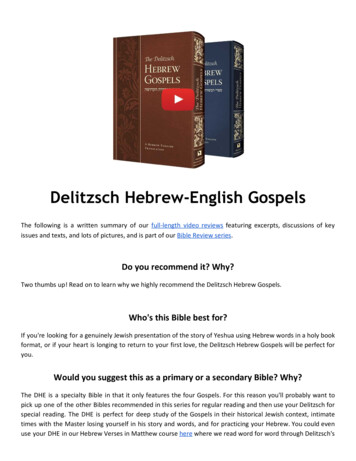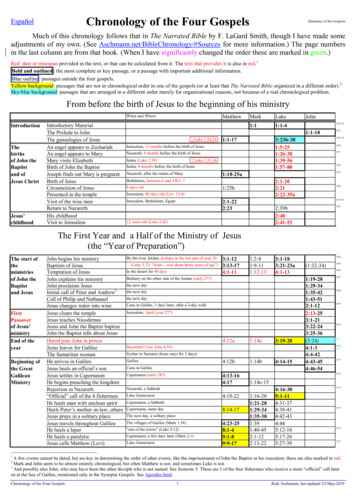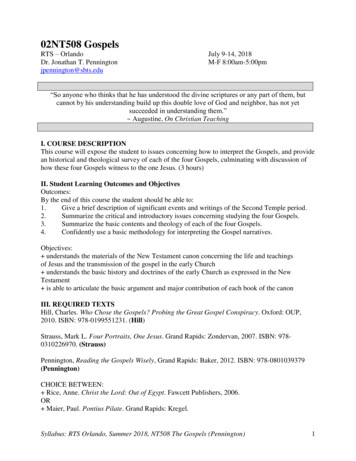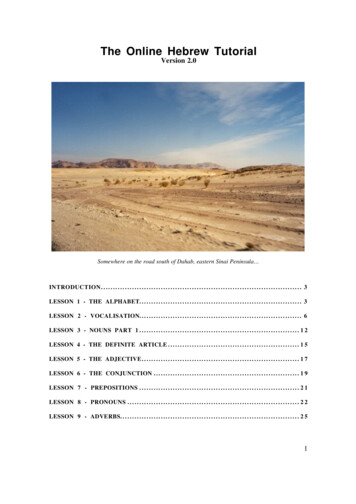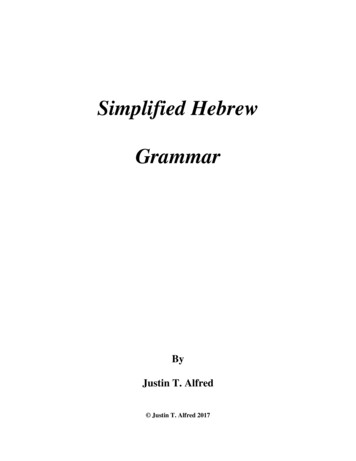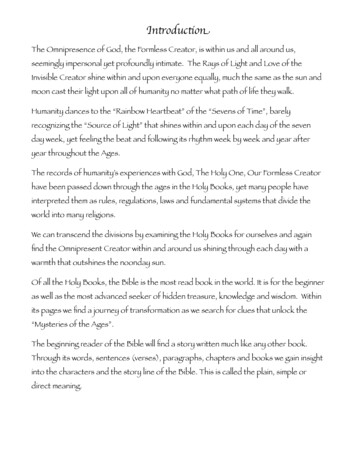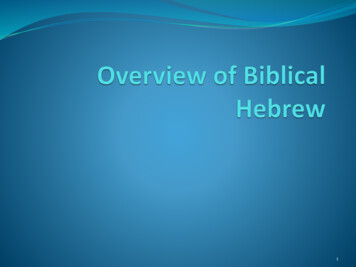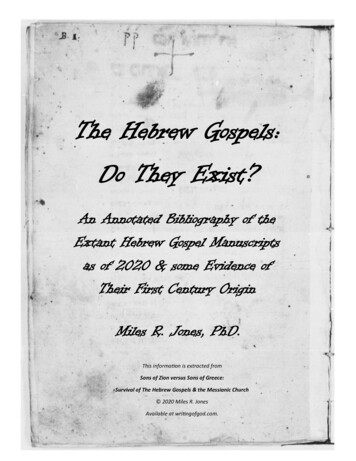
Transcription
The Hebrew Gospels:Do They Exist?An Annotated Bibliography of theExtant Hebrew Gospel Manuscriptsas of 2020 & some Evidence ofTheir First Century OriginMiles R. Jones, PhD.This information is extracted fromSons of Zion versus Sons of Greece:Survival of The Hebrew Gospels & the Messianic Church 2020 Miles R. JonesAvailable at writingofgod.com.1
AcknowledgementFor the sake of simplicity I have only included the Hebrew manuscripts ofthe Gospels and New Testament in this first Annotated Bibliography. There areother manuscripts that are well established to have come from the Hebrew Manuscript Tradition. In other words, The Hebrew Gospels were translated into theearly European languages. Among these manuscripts are The Catalan Gospels,The Waldensian Gospels, and The Romaunt Gospel of John. These are extremelyimportant documents in their own right as well as for establishing the HebrewManuscript Tradition. They will be added in later updates of this bibliography.Nor have I included all of The Hebrew Gospel manuscripts. There areabout 42 extant manuscripts of the Shem Tov Hebrew Matthew. I have onlylisted one of those here. There are additional manuscripts extant as well of TheHebrew Gospels from Catalonia. One particularly interesting manuscript is TheBreslau Hebrew Gospels which includes the Shem Tov Hebrew Matthew alongwith Mark, Luke and John from The Hebrew Gospels from Catalonia. There is aHebrew manuscript of the Epistle of 2nd Peter which I have not included. Thereare others that I know of but have not yet obtained copies in order to study them.There will be others, of that I have no doubt.All of these texts need to be authenticated. That extremely important workhas only just begun. For that reason I have included Appendix A which gives evidence of the authenticity of The Hebrew Gospels. I will continue to update thisAnnotated Bibliography of The Hebrew Gospels as more come to light. Thelatest update will always be available at writingofgod.com for free download. 2020 Miles R. JonesThis is an open copyright document which may be copied and distributed atwill as long as it is free, unaltered, and the original copyright notice andauthorship are included & acknowledged!There will be updates - the most current document will always be availablefor free download on writingofgod.com.2
The Hebrew Gospels: Do They Exist?page:5Preface6Hebrew Gospels from Catalonia7Cochin Hebrew Gospels8Cochin Hebrew New Testament9Cochin Gospel of Revelation10Cochin Hebrew N.T. Epistles11Cochin Hebrew Gospel of John12Shem Tov Hebrew Manuscript13Vatican Hebrew Manuscript #53014Hazon Hebrew Manuscript of Revelation15Hebrew Epistles of James & Jude16Appendix A - First Century Origin of The Hebrew Gospels21Appendix B - Books & Book Reviews31Appendix C - Bar Mitzvah Program3
Dr. Miles R. Jones is an internationally renowned expert in accelerated learning oflanguages, mathematics and memory training - who operates a center for home-schooling. Hewas called from teaching CEO’s and top executives in Europe, the Middle East, the U.S., andMexico to teach in inner-city schools in Dallas, Tx. He taught in the inner-city for six yearsbefore becoming an education professor at Texas A & M.Previous work as a director of university English programs in the United Arab Emiratesand as a specialist with the U.S. government in Yemen training military officers, allowed himto begin his research in the field. As an historical linguist, the origin of the alphabet hadalways captivated him. There had only been one alphabet in history from which all others arederived. That original alphabet appeared in the path of the Exodus at the time of the Exodus.The Writing of God is the result of decades of expert research on the origin of the alphabet.Dr. Jones is now translating the earliest surviving manuscripts of The Hebrew Gospels.The history of The Hebrew Gospels and the Messianic Church throughout history are outlinedin his new book:Sons of Zion vs Sons of Greece - Volume One: (2019)Survival of the Hebrew Gospels and the Messianic Church(See Appendix B for more information)Dr. Jones received his PhD in Foreign Languages & Linguistics at the University of Texas atAustin in 1985. He has taught worldwide and developed accelerated curriculum in numeroussubjects, including Spanish, French, Hebrew, ESL, Mathematics, Speed Reading, & MemoryTraining.4
PrologueEverywhere I go to teach about The Hebrew Gospels, whether in person or via the internet, I bump upagainst the ‘expert’ academic opinion that there is “absolutely zero evidence of The Hebrew Gospels!”Certainly I hear this from professors, researchers and pastors but it is also reflected by Christian and Messianicbelievers. It is conveyed with the certitude that it is the ‘gospel truth!’ I usually carry a copy of The HebrewGospels from Catalonia (Matthew, Mark, Luke & John). Participants can hold the manuscript in their handsand turn the pages, see the translation notes in the margins, etc. I have spent the last several years translatingthis manuscript and others. You will see page views from them in this ebook.Finally, it occurred to me that since I had already found three Gospel manuscripts from the originalHebrew. There must be more! In December 2019, I organized a spur-of-the-moment research blitz of a fewof the major research libraries in Europe. The first day I went to Cambridge University Library anduncovered four previously unknown manuscripts of The Hebrew Gospels from Cochin, India where theApostle Thomas went to evangelize in the first century. Two days later I discovered a fifth manuscript of TheHebrew Gospels at Rylands Library in Manchester, England. By the end of the trip I had recovered two moremanuscripts, in Catalan and Roumant, which had been translated from The Hebrew Gospels. Markers of theHebrew Manuscript Tradition have now been established and they are clear and definitive. (See Appendix B)I obtained digitized copies of these documents to study and translate. Many, if not most, had neverbeen digitized or even listed in the library catalog. That means practically no one has ever seen them! Thereare significant differences between The Hebrew Gospels and The Greek Gospels. These differences do notchange the Gospel story - but they do add tremendous depth to the Hebrew perspective never before seen. Thehard truth is that everything we know about our Hebrew Messiah comes to us through the Greek filterof a different language, culture and thought! There is a method to the madness of those who changedthings in the Greek and Latin Gospels. The changes were clearly made to support the doctrines of the newlyformed Greco-Roman Church. The B’nai Emunah Institute is dedicated to restoring The Received Text!These changes are highly significant and the reader who wants to see the evidence and analysis,in-depth, can start with my book Sons of Zion vs Sons of Greece: Survival of The Hebrew Gospels and TheMessianic Church (available at writingofgod.com). One should not read this ebook (an annotated bibliography) and jump to conclusions. It is only the tip of the iceberg! Nonetheless, I have included in Appendix Asome of the most basic evidence that proves the first century origin of some of these Hebrew manuscripts.The evidence of first century origin is essential. The reason there has been no awareness of TheHebrew Gospels is because of the belief in Greek Primacy of the Bible. “All the books of the New Testamentwere originally written in Greek!” The corollary to that premise is that no Hebrew Gospel exists - nor everexisted! This premise cannot survive even a cursory review of early church literature. Remember that everysingle one of the N.T. books were written by Hebrew authors (in Greek?). The Christian Church fathersfrequently commented, in the early church literature, that the original Gospel (Matthew) was written inHebrew. To give you a quick summary; Luke - as well - was originally written in Hebrew but when translatedlater into Greek much was added to it. Luke is a hybrid. Hebrews, Peter, James, Jude and Revelation wereoriginally from Hebrew manuscripts. Acts is in question. The other N.T. manuscripts were initially in Greekas far as we know. Those originally Greek books of the New Testament were translated early on into Hebrewand compiled along with The Hebrew Gospels, so that an entire Hebrew New Testament was available to theMessianic Church. This Hebrew-speaking Messianic Church was the core of Christianity for centuries. Mybook Sons of Zion was written to document this all-important story - the greatest story never told! This ebookhas a very limited purpose - to prove The Hebrew Gospels existed in the first century and have survived!Miles R. Jones, 2020, Director, Benai Emunah Institute, go to writingofgod.com5
The Hebrew Gospels from Catalonia [HGC]Vat. Ebr. 100 (Vaticano Ebreu Manuscrito #100)The text is 304 pages, including the books of Matthew, Mark, Luke and John in Hebrewalong with prefaces to Matthew, Mark & Luke by St. Jerome in Hebrew as well. Jerome, by hisown declaration, had translated The Hebrew Gospel(s) into Greek and Latin - apparently adding the Hebrew prefaces at the same time. This is a 15th century manuscript which has beenvalidated as coming from a first century source. See Appendix A for a brief summary analysis ofof that proof. This was copied by Messianic scribes, believers in the Hebrew Messiah, who usedHebrew conventions such as substituting Adonai, Hashem, Elohim, etc. for the name ofYehovah. They risked being burned at the stake for copying, or even being in possession ofThe Hebrew Gospels. The name of the Messiah is used in Hebrew - Yeshuas Mashiach.Although more work needs to be done to ascertain the journey of this manuscript, historicalattestation cites The Hebrew Gospels as being extant in the Medieval period in Spain where itwas translated into Catalan. A century later it was translated back into Hebrew - probablybecause the original Hebrew document was no longer available - either lost, destroyed by theInquisition, or taken into hiding underground. The Hebrew preface to Matthew says, “The firstevangelist wrote this in the holy tongue for his brothers ” The acknowledgement in the prefacethat The Hebrew Gospel was originally written in Hebrew (the holy tongue “lashon hachodesh”)is one of several markers of the Hebrew Manuscript Tradition. [See Appendix B]Judaea(315-403 AD)6KingHerodusIn the days
The Cochin Hebrew GospelsRylands Library - Manchester, U.K.Hebrew Manuscript #1616The manuscript has 584 pages and includes all four Gospels & Acts of theApostles, all of the Epistles and the book of Revelation. It is a complete text of TheHebrew New Testament, one of two complete texts of the New Testament in theCochin Collection. These Gospels have been ascertained to have come from a firstcentury source! See Appendix A for a brief summary of the analysis of this evidence. It was discovered in 1806 at the Synagogue of the Black Jews of Cochin andrecopied from the “ancient Jerusalem script” by Claudius Buchanan in 1810.Cochin, in India, was the territory where the Apostle Andrew evangelized and established a church that continues to this day. Bartholomew was cited by Eusebius inthe early church literature as taking a copy of The Hebrew Gospel to Cochin in thefirst century. In the second century, Pantaenus was cited as sojourning there andreturning to Alexandria with a copy of The Hebrew Gospel. Apparently, the Messianic community of Cochin preserved the Gospels and added Hebrew translations ofthe Greek epistles in order to have a complete Hebrew compilation of the N.T.First page of The CochinHebrew Gospels says:The book of the GospelGood News of MatthewGood News of MarkGood News of LukeGood News of John7
The Cochin Hebrew New Testament [CNT]Cambridge Library Oo.1.32 (in the Manuscript Collection)The manuscript is 373 pages, including all four Gospels, Acts of the Apostles,all of the Epistles - but no book of Revelation. Below is the first page of that document. The manuscript did not have a cover so the first page is discolored and wornfrom exposure. The rest of the manuscript is in much better condition. It is quitereadable, although hand written in a script that is somewhat peculiar.The Cochin Collection also contains another manuscript which is the complete textof Revelation [see next page]. Although it is definitely a different manuscript it hasbeen bound along with the Cochin Hebrew N.T. in order to have a complete text.8
The Cochin Hebrew Gospel of RevelationCambridge Library Oo.1.16.2Bound with The Cochin New TestamentThis is the first complete manuscript of the Hebrew Book of Revelation everdiscovered! The age of this manuscript has yet to be determined. The Cochin Gospels are also a complete Hebrew N.T. including Revelation. So that means we havetwo (early) Hebrew manuscripts of Revelation. However, it has yet to be determined if The Cochin Gospels (& N.T.) were, in fact, recopied from the manuscriptof The Cochin Hebrew New Testament. Nonetheless, having the first completeHebrew manuscript of Revelation with some claim to authenticity is an enormousdiscovery! The translation, analysis, and comparison of this manuscript with otherssuch as The Cochin Hebrew N.T. and the Hazon Manuscript of Revelation couldhelp establish the authentic original Hebrew text of Revelation. Various scholarshave opined that Revelation comes from a Hebrew subtext, meaning that an analysisof the underlying syntax shows Revelation to be of Hebrew origin.9
The Cochin Hebrew N.T. EpistlesCambridge University LibraryOo.1.16.1This manuscript includes the Hebrew text of Acts of the Apostles, Romans,1st & 2nd Corinthians, Galatians, and Ephesians. An early presumption about thismanuscript is that it contains Hebrew translations of the Greek Epistles in order tocompile them with the Hebrew elements to achieve a complete Hebrew New Testament. That remains to be seen. The Hebrew origin of Acts is in question. Lukewrote both the Gospel of Luke and Acts as a two part letter to Theophilus. Weknow Luke was originally written in Hebrew - so logically Acts was as well. See thecomplete evidentiary analysis of the Hebrew origin of Luke in Sons of Zion vs Sonsof Greece. This manuscript of Acts should help to answer that very importantquestion.10
The Cochin Hebrew Gospel of JohnCambridge Oo.Add.170 (in the Manuscript Collection)The Gospel of John raises so many historical questions. Many historians nolonger believe that it was written by the Apostle John. Apparently, the early churchfelt a Greek Gospel by an Apostle was needed to counterbalance the Hebrew Gospel of Matthew - otherwise, the only eye-witness testimony to the Messiah is fromHebrew, not a good thing to the early Greek Church. John has the least historicalattestation as to its author. It was heavily edited by its Greek editors, more than 60third person insertions are in the text, giving the “Love Gospel” the dubious distinction of having the most anti-Judaic statements in the New Testament. This Hebrewmanuscript of John may go a long way towards answering those historical questions.See Sons of Zion vs Sons of Greece for a detailed assessment of its authorship.11
The Shem Tov Hebrew Matthew: The TouchstoneVat. Ebr. 101 (Vaticano Ebreu Manuscrito #101)The Hebrew Matthew portion of the manuscript is 75 pages. So far this is the onlyHebrew Gospel that has been translated into English. The translation was done by GeorgeHoward - Mercer University Press in 1995. The Shem Tov Manuscript of Hebrew Matthew wasentitled The Touchstone [‘Evan Bohan’ in Hebrew]. It is an amazing work of eleven chaptersonly one of which is the Hebrew Matthew. The other chapters discuss differences in the GreekSeptuagint translation from the Hebrew text of the Tanakh (Old Testament). This major part ofthe document has never been translated. It will be of great value in recovering the ReceivedText of the Bible. The Shem Tov, as it is called, was widely copied and recopied among theMessianic communities throughout the centuries. So far we know of 42 manuscripts of theShem Tov. Fourteen of these have been recovered by Nehemia Gordon from Eastern Europe.In 1385, Shem Tov Ibn Shaprut transcribed from an extant copy of The Hebrew Gospels- the book of Matthew - in order to annotate it with debate argumentation. Shem Tov and otherJewish leaders were being forced to debate Christians over the truth of the Gospels. If they lostthe debate, they and their whole community would be forced to convert to Christianity. ShemTov planned to do the same with Mark, Luke and John but never completed them. His is notthe only historical attestation of The Hebrew Gospels surviving in Medieval Spain!Beginning ChapterThese are the generations of Yeshua,son of David, son ofAbraham.12
Vatican Hebrew Manuscript #530Vat. Ebr. 530 - Framento 11 (Fragment #11)Vaticano Ebreu Manuscrito # 530 - Framento 11This fragment is four pages from what was a complete manuscript of The Hebrew Gospels. It includes the title pages of both Luke and John. It’s importance comes from the factthat it is a new document - although it is clearly from the Hebrew Manuscript Tradition - itdoes not seem to be copied from the same source document as The Hebrew Gospels fromCatalonia or The Cochin Gospels. So, if this holds true, there was another surviving branchof the original Hebrew manuscript texts of the first century.Note the small red box in the left margin. In Vat. Ebr. 530 (fragment 11) the name ofGod - Yehováh - is used throughout including the vowel pointing so there is no doubt as to itscorrect pronunciation. This partial pageview is from the title page of Luke, the title below says“Beginning Chapter.” The first line says “And it was in the days of Herodos king of Judaea ”Epiphanius (315 403 AD), the Jewish Christian Bishop of Salamis, cited this as the first line ofThe Hebrew Gospel [of Luke]. This is also the first line in The Hebrew Gospels from Catalonia [HGC] in Luke 1:5. Luke verses 1:1-4 are not part of The Hebrew Gospel. See Sons ofZion versus Sons of Greece for the detailed analysis. Luke 1:1-4, called the prologue to Luke inthe Greek Gospels, basically say that it is a copy of earlier documents from the Apostles. TheHebrew Gospel of Luke does not say it is a copy! Logically therefore, it is likely to be original.13
The Hazon Hebrew Manuscript of RevelationBritish Library - Sloane Collection Manuscript #273This manuscript is the first seven pages of Revelation - from chapter one, verseone, to chapter two, verse twelve. Chapter one, verse eight in the red box belowreads, “I am the Aleph and the Tav, said Yehováh Elohim - Who is, Who was,Who is to come, ‘HaShaddai’ The Almighty.” Note that this manuscript uses thename of God - Yehováh - with the correct vowel pointing, often a marker of Messianic scribes. Also, instead of saying the Alpha and Omega, first and last letters ofthe Greek alphabet, it says Aleph Tav, first and last letters of the Hebrew alphabet.The Aleph Tav (Alpha Omega in Greek) was the phrase used to mean the‘alphabet’ before that term came into use many centuries later. Here, God is literally claiming the alphabet is of Him. See The Writing of God for more researchevidence of the first alphabet of letter-symbols being given at Mount Sinai.14
The Hebrew Epistles of James & JudeBritish Royal Museum Manuscript #16 A IIThese Epistles are listed as Hebrew translations of the Epistles of James and Jude with aLatin dedication to Henry VIII. They are 16th century (1500-1599 AD) copies. They werepresented to the British Museum by George II in 1757 from the old Royal Library. Note thatsince it is presumed The Hebrew Gospels do not exist any such manuscripts would be assumedautomatically to be a translation. Now with the discovery of the Cochin Collection we may beable to ascertain their authenticity, or lack of it, by comparison with the Cochin Hebrew Epistles.There is also a Hebrew manuscript of 2nd Peter in the British Library. These apostleswere Hebrews who did not know Greek (Acts 4:13). They would have written or dictated theirletters in Hebrew. There is no reason to dismiss the possibility of Epistles by Peter, James, Judeand John in Hebrew. In fact, that was the most likely outcome. Remember the MessianicChurch was predominantly Hebrew during their lifetimes. The family of faith they would havewritten to would have been Hebrews. Establishing authenticity is the first step for all of theseHebrew manuscripts. Little of that work has been done up to this point.15
Appendix AA Brief SummaryOf the Evidence of theAuthenticity ofThe Hebrew Gospels16
Authentication of the Hebrew Gospels from CataloniaThe most important question concerning The Hebrew Gospels from Catalonia is theirauthenticity. Do the Hebrew Gospels from Catalonia [HGC] come from the original HebrewGospel of the first century? The original Hebrew Gospel would be Matthew, and probablymuch of Luke. Attestations indicate the other Gospels were available to the Messianiccommunity in Hebrew translation, therefore a compilation of The Hebrew Gospels wasinevitable. So, to simplify matters, in this book, a reference to The Hebrew Gospel (singular)would be Hebrew Matthew, and part of Luke, whereas The Hebrew Gospels (plural) woulddenote the compilation of all four Gospels as in The Hebrew Gospels from Catalonia [HGC].In Jerome’s Commentary on Matthew, he states that, in The Hebrew Gospel, anothername is used for Bar Abbas, the criminal who is released by Pilate. Jerome cites his name as“son of their teacher in the Gospel according to the Hebrews.”38 “Barabbas ( )בר אב is anAramaic name meaning ‘son of the father,’ whereas ‘son of their teacher’ would be בר רבנ [Bar Rabban].”39 In The Hebrew Gospels [HGC] - the released prisoner is referred to fourtimes as Bar Rabban (Matthew 27:16,17,20,21), ‘son of the teacher’ - never as Bar Abbas.So we have external evidence, an historical attestation by Jerome, of the name Bar Rabban used in The Hebrew Gospel. We also have internal evidence from The Hebrew Gospelsfrom Catalonia [HGC] which used Bar Rabban all four times his name is mentioned. I canthink of no possible way this could have happened by chance or by collusion. One correlation,however, can always be dismissed. One correlation is a coincidence. Two is a pattern!The ideal authentication of The Hebrew Gospels [HGC], would have these criteria:1. A credible ancient source citing events and/or quotations in the original Hebrew Gospelthat differ from the Greek Gospel,2. Multiple ancient citations of that same event or quotation,3. Independent historical confirmation of the event/quotation,4. Confirmation of the same event or quotation from the text of The Hebrew Gospels [HGC].*These excerpts are taken from pp. 168-169 of Sons of Zions versus Sons of Greece, 2019, by Miles R. Jones.38Jerome, Commentary on Matthew, 27.16.39James Edwards, The Hebrew Gospel, 2009:p.88.17
Breaking of the Lintel in The Hebrew GospelsIn three instances Jerome preserves evidence of a tradition in the early church of the breaking ofthe Temple lintel stone rather than the Temple curtain at the crucifixion of Jesus (Matt. 27:51;Mark 15:38; Luke 23:45).40 “In the Gospel we often mention, we read that the immense templelintel fell and broke to pieces.”41 Again, “In the Gospel, however, which is composed in Hebrew,we read not that the Temple curtain was torn but that the Temple lintel of wondrous size fell.”42In The Hebrew Gospels [HGC], it is the breaking of the stones of the Temple that arecited, which felled the lintel stone at the entry of the Holy of Holies. Compare the versesgiven in the King James Bible [KJV] to The Hebrew Gospels [HGC]:HGC Matt 27:51“And here the Temple was broken on both sides up and down and the earth quaked and thestones split in the middle.”KJV Matthew 27:51“And, behold, the veil of the temple was rent in twain from the top to the bottom; and theearth did quake, and the rocks rent.”HGC Mark 15:38 “The temple was broken on both sides up and down.”KJV Mark 15:38 “And the veil of the temple was rent in twain from the top to the bottom.”HGC Luke 23:45 “The sun went dark and covered the temple and it was split in the middle.”KJV Luke 23:45 “The sun was darkened, and the veil of the temple was rent in the midst.”The earthquake would account for the breaking of the large lintel stone over theentrance to the inner Temple, “the stones split in the middle.” Note that the damage wouldalso have torn the veil hanging beneath the lintel. However, the veil alone could hardly beripped by an earthquake absent other damage. The early first century church tradition ofthe breaking of the lintel - as preserved by Jerome from The Hebrew Gospel - is confirmedin all three verses of The Hebrew Gospels from Catalonia. Now we have a pattern! *In The Cochin Hebrew Gospels we find exactly the same pattern of the stones of theTemple - the Holy of Holies - split in all three verses; Matt 27:51, Mark 15:38, and Luke 23:45!40James Edwards, The Hebrew Gospel & Development of the Synoptic Tradition, 2009, p.88. 41Jerome, Commentary on Matthew 27:51. 42Jerome, Epistle 120.8.2, Ad Hedybiam. *See Sons of Zion for more evidence.18
THE HEBREW GOSPELS PROJECTThe B’nai Emunah Institute has taken on the task of compiling adefinitive version of The Hebrew Gospels from surviving texts of the HebrewManuscript Tradition. The Hebrew Gospels from Catalonia [HGC] is one surviving text containing all four of the Gospels in Hebrew. Another manuscriptfrom the same time and place is the Shem Tov Hebrew Matthew, called the EvanBohan - ‘The Touchstone.’ There are far too many similarities between the HGCand the Shem Tov Matthew [STM] to be a coincidence - and far too few for it tobe a copy. It is very clear the HGC & STM both came from a common originalHebrew manuscript. Here are a few, of many, verses which exist in no otherversion of the Gospel, verses which help lead us to a deeper grasp of our HebrewMessiah:Correlations between The Hebrew Gospels from Catalonia [HGC]and the Shem Tov Hebrew Matthew [STM]In Matthew 1:19 the KJV says Joseph is concerned Mary will be put to shame forbecoming pregnant. The HGC & STM say Joseph is worried about Myriam beingput to death.In Matthew 13:55 the KJV says “son of the carpenter” but both the HGC & STMsay Yeshua is the “son of the smith” ( )בנ נפח . [In Greek it says ’technon’ - builder]In Matt 8:5-6 the KJV says a centurion came to Yeshua “saying my servant lies athome sick.” The HGC & STM say “my son ( )בני lies at home sick ”In Matthew 5:35 the KJV says “Jerusalem city of the Great King” while theHGC and the STM say “city of God.” There is a scholia (note) in the margin ofthe Codex Sinaticus of the Greek Septuagint at Matt 5:35 which says “In theHebrew Gospel it says city of God.”In Matt 12:42, the KJV says “The queen of the south shall rise up in judgement.”The HGC & STM say “The queen of Sheba will rise up in judgement.”In Matthew 28:9 of the KJV “Jesus met them saying, All Hail.” In the HGC,Yeshua says “[May] God save you.” - in the STM “[May] God deliver you.”19
SURVIVAL OFTHE HEBREW MANUSCRIPT TRADITIONThe Hebrew Gospels from Catalonia [HGC] and the Shem Tov Matthew[STM] were both written in Hebrew in Spain within the span of a century. Theyare two examples of a Hebrew Manuscript Tradition that survived outside of thehegemony of the Roman Church. Other manuscripts - examplars of the HebrewManuscript Tradition have recently been found! The Cochin Gospels and CochinNew Testament in Hebrew - The Waldensian Bible in Roumant and The CatalanGospels. The Waldensians were martyred by the Roman Church for millenia fornot accepting Rome’s authority and interpretation of Scripture. According to theiroral tradition, their Roumant Bible predated the Latin Vulgate.I have found markers that designate texts originating from the HebrewManuscript Tradition. Here are the four markers:1) The name of the Messiah is derived fromHebrew - Yeshuas, Yeshua or Yeshu.2) Where it says “son of Man” in the Vulgate, KJV, etc.,it often says “son of the virgin” in the HGC and the Roumant Bible(although not in the STM).3) KJV John 1:1 “In the beginning was the Word, and the Word was withGod, and the Word was God.”In the Roumant book of John it says “In the beginning was the Son, andthe Son was with God, and the Son was God.”The HGC says “In the beginning was the Son Eloah, and the Son of El waswith El.”4) The preface to the Gospels in the Hebrew Manuscript Tradition willoften state that the Gospel was originally written in Hebrew.20
Appendix BBooks by Dr. Miles Jones&Book Reviews21
ְּבנֶי אֶ מּונָה Institute for Accelerated LearningB’nai Emunah - Household of FaithLet us do good to all, but especially to thoseof the household of faith. Galatians 6:10B’nai Emunah is a non-profit educational & religious institute dedicated to restoring theoriginal Messianic Church of the first century through research and education.121 Mountain Way Drive, Kerrville, Tx 78028 - phone 214 546 7893, writingofgod.comHEBREW INSCRIPTIONS DISCOVERED !The first photographic and video evidence wasbrought out by Jim & Penny Caldwell in 1992. Sincethen dozens of books and documentaries have beendone on the discovery of the real Mount Sinai inMidian. In 2002, Dr. Miles Jones contacted theCaldwells and they shared with him photographs ofancient inscriptions from the base of Mount Sinai andfrom Rephidim. The inscriptions from Rephidim werethe footprints of the Israelites traced into the stones withan alphabetic caption which said they were the “soles oftheir feet,” written in the oldest alphabet known tolinguistic science, the Thamudic alphabet. Four otherinscriptions were deciphered by Dr. Jones, all funerary.One said “Died Amalek”, another “Died Hagar” andanother “Died Amiah daughter of Hagar” - all written inancient Hebrew - telling a story st
5 Prologue Everywhere I go to teach about The Hebrew Gospels, whether in person or via the internet, I bump up against the ‘expert’ academic opinion that there is “absolutely zero evidence of The Hebrew Gospels!” Certainly I hear this from professors, researchers and pastors but i


